Wow thanks for the pics of the torrent, I did wonder what it may be like when risen and now I know.Thanks Jon. It is indeed a real watercourse, called the Red Burn, it flows down into the River Don. And of course when we designed the line, it just had to be crossed (twice). In the summer it’s a very pleasant babbling brook and a good watering hole for the dogs.
View attachment 307548
View attachment 307551
However, it‘s a very different story after increasingly more frequent torrential rain and a sobering reminder of why it was a great idea to ridiculously over-engineer the bridges (2m sections of steel plate bolted to a pair of box girders) - strong enough to walk across and thankfully still standing after 16 years.
View attachment 307549
View attachment 307550
Greetings from NE Scotland
- Thread starter Granitbahn
- Start date
tramwayknowledge
Tramway Modelling
Welcome to the group Chris and Jo. Your layout and garden look magnificent. My partner and I lived for 7 years in Aberdeen/Banffshire between Turrifff and Banff (hardy northeners not 'soothern softies living near the River Don' lol.). I was planning garden railway and spent many evenings on the internet buying in 'come in useful' stock. Unfortunately, restoring a 300 year old house, plus half an acre - plus of 'garden and arboretum' and a couple of heart attacks took all of my limited spare time. So when we moved to a house on Doctors Orders;
'' less than 7 bedrooms and half an acre of jungle, or else''...
.''Yes Doctor, we promise''
I had the small garden repaved, landscaped and chunky posts put in to support an elevated line this time.(I am getting too old for all that bending down) I am now at last in the process of building stock and laying track for an 'Electrische Kleinbahn/Tranvie Electrico. I am on the sick list atm. but hope to have the line open by next summer, so I will post some pictures.
'' less than 7 bedrooms and half an acre of jungle, or else''...
.''Yes Doctor, we promise''
I had the small garden repaved, landscaped and chunky posts put in to support an elevated line this time.(I am getting too old for all that bending down) I am now at last in the process of building stock and laying track for an 'Electrische Kleinbahn/Tranvie Electrico. I am on the sick list atm. but hope to have the line open by next summer, so I will post some pictures.
Granitbahn
Chris Bird & Jo Chapman
Thanks for the welcome and kind words. Sorry to hear that the big restoration project up north was never realised but wishing you better health and success in the new tramway project. The elevated line is definitely the right way to go.Welcome to the group Chris and Jo. Your layout and garden look magnificent. My partner and I lived for 7 years in Aberdeen/Banffshire between Turrifff and Banff (hardy northeners not 'soothern softies living near the River Don' lol.). I was planning garden railway and spent many evenings on the internet buying in 'come in useful' stock. Unfortunately, restoring a 300 year old house, plus half an acre - plus of 'garden and arboretum' and a couple of heart attacks took all of my limited spare time. So when we moved to a house on Doctors Orders;
'' less than 7 bedrooms and half an acre of jungle, or else''...
.''Yes Doctor, we promise''
I had the small garden repaved, landscaped and chunky posts put in to support an elevated line this time.(I am getting too old for all that bending down) I am now at last in the process of building stock and laying track for an 'Electrische Kleinbahn/Tranvie Electrico. I am on the sick list atm. but hope to have the line open by next summer, so I will post some pictures.
Jo’s dad is a retired engineer. When he was 80, I suggested that he could put all those skills into building a railway in his small back garden on the edge of the New Forest, and he opted for the elevated route. Within a few years, the line expanded to reach every corner of the garden and he embraced every aspect of his new passion, particularly enjoying his first live steamer, an Accucraft Ragleth, when he was 90. Sadly, now approaching 97, he no longer has the capacity to operate the railway but still loves to hear of our progress. Ragleth was offered to us a few months ago (yes, please) and steams again, after several years of inactivity. Here’s the old boy in his prime - ’you‘re never too old to be young again’
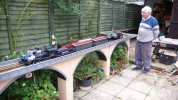
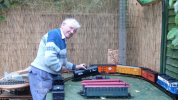
He made a fine job of the viaduct, any more information on that please?Thanks for the welcome and kind words. Sorry to hear that the big restoration project up north was never realised but wishing you better health and success in the new tramway project. The elevated line is definitely the right way to go.
Jo’s dad is a retired engineer. When he was 80, I suggested that he could put all those skills into building a railway in his small back garden on the edge of the New Forest, and he opted for the elevated route. Within a few years, the line expanded to reach every corner of the garden and he embraced every aspect of his new passion, particularly enjoying his first live steamer, an Accucraft Ragleth, when he was 90. Sadly, now approaching 97, he no longer has the capacity to operate the railway but still loves to hear of our progress. Ragleth was offered to us a few months ago (yes, please) and steams again, after several years of inactivity. Here’s the old boy in his prime - ’you‘re never too old to be young again’
View attachment 307773
View attachment 307774
I was going to ask the very same question!He made a fine job of the viaduct, any more information on that please?
Granitbahn
Chris Bird & Jo Chapman
Afternoon all. Temperature outside has rocketed from -10C to +4C with a strong southerly wind since 7am. Heavy rain later and a rapid thaw sounds like a recipe for flooding!I was going to ask the very same question!
So, the viaduct.……bearing in mind I was not present at its construction 13 years ago, I’ve delved into the photo archive but slim pickings. I can recall that a sturdy post and top rail construction came first to ensure what followed would be both vertical and level. The viaduct was formed with 6 identical arch modules which interlocked and were bolted together with additional box sections forming the pillars and hiding the posts. Assorted wooden materials were used (photos below may provide a clue) and the underside of each arch was formed from flexible plastic sheet. The end result was very sturdy and looked really good. I know a lot of effort went into it.
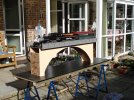
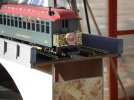
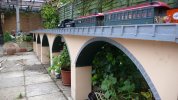
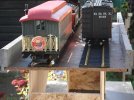
The structure lasted around 8 years before it started to suffer from water damage and rot in the arches whilst the superstructure and rail bed remained sound. I remember Dennis saying that if the had to do it again, he‘d use thicker marine ply and more durable materials in general as well as importantly varnishing/waterproofing the interiors of the arch modules as they eventually rotted from the inside out. He decided to replace the viaduct with a simpler structure that required less maintenance. It still looked pretty good!
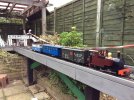
Thanks from me as well, an interesting resume into the what and how plus a timely reminder of the perils and short life of ply in the garden.
These days the Sterling Board used inside could be replaced by Plastic Decking. The outside and detail could have been made of Plastic Coated Foam Board (at a price) as could the other detail. Not in any way a criticism of Jo’s dad’s superb work, just my thoughts on how a longer life copy could be made.
These days the Sterling Board used inside could be replaced by Plastic Decking. The outside and detail could have been made of Plastic Coated Foam Board (at a price) as could the other detail. Not in any way a criticism of Jo’s dad’s superb work, just my thoughts on how a longer life copy could be made.
craigwrdouglas2
Registered
It all looks fantastic, I wish I had the space that you do.
I think we all do!It all looks fantastic, I wish I had the space that you do.
DafyddElvy
1:22.5 & 15mm Scale Trams, , NG Steam Railways
I'd 3rd thatI think we all do!
